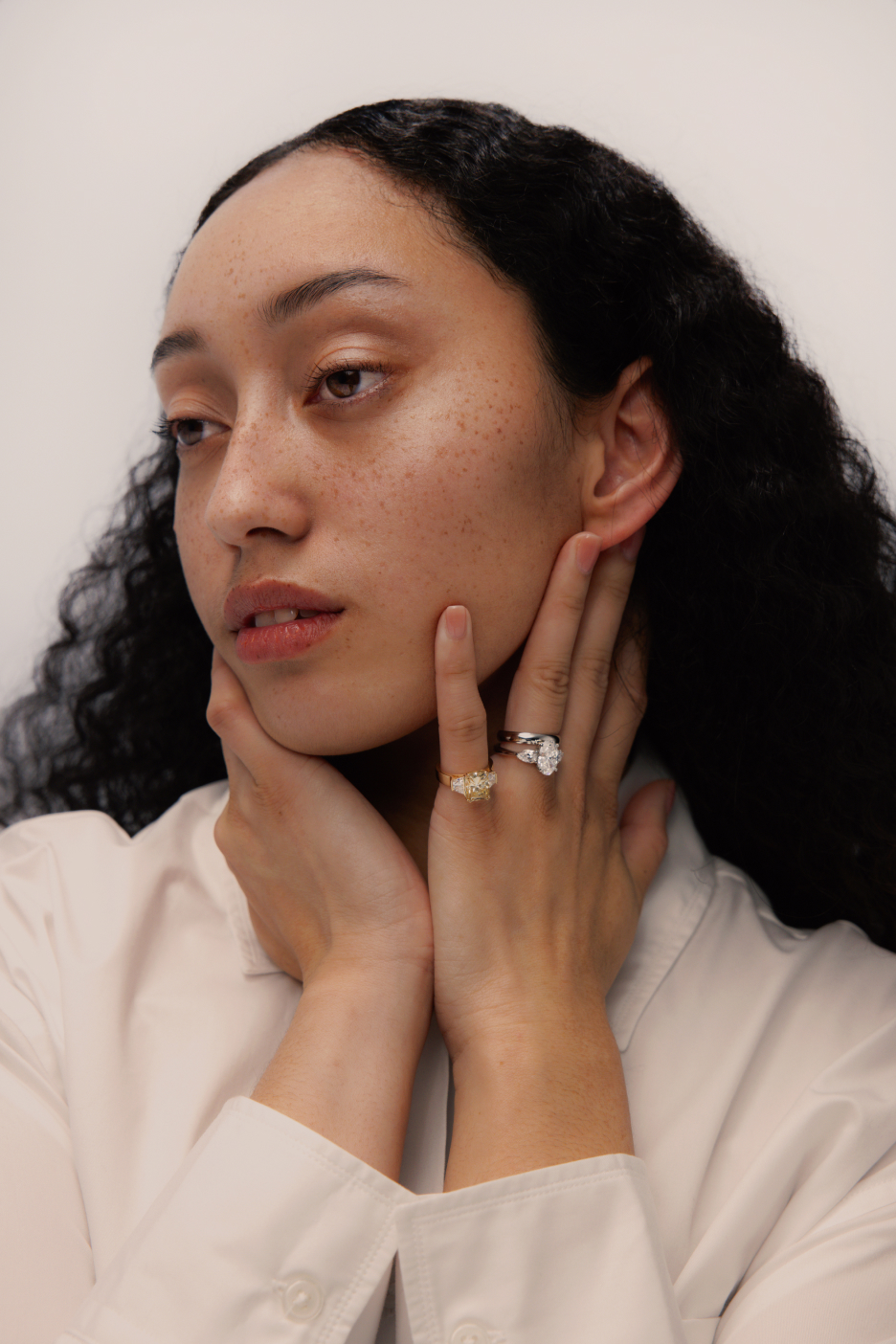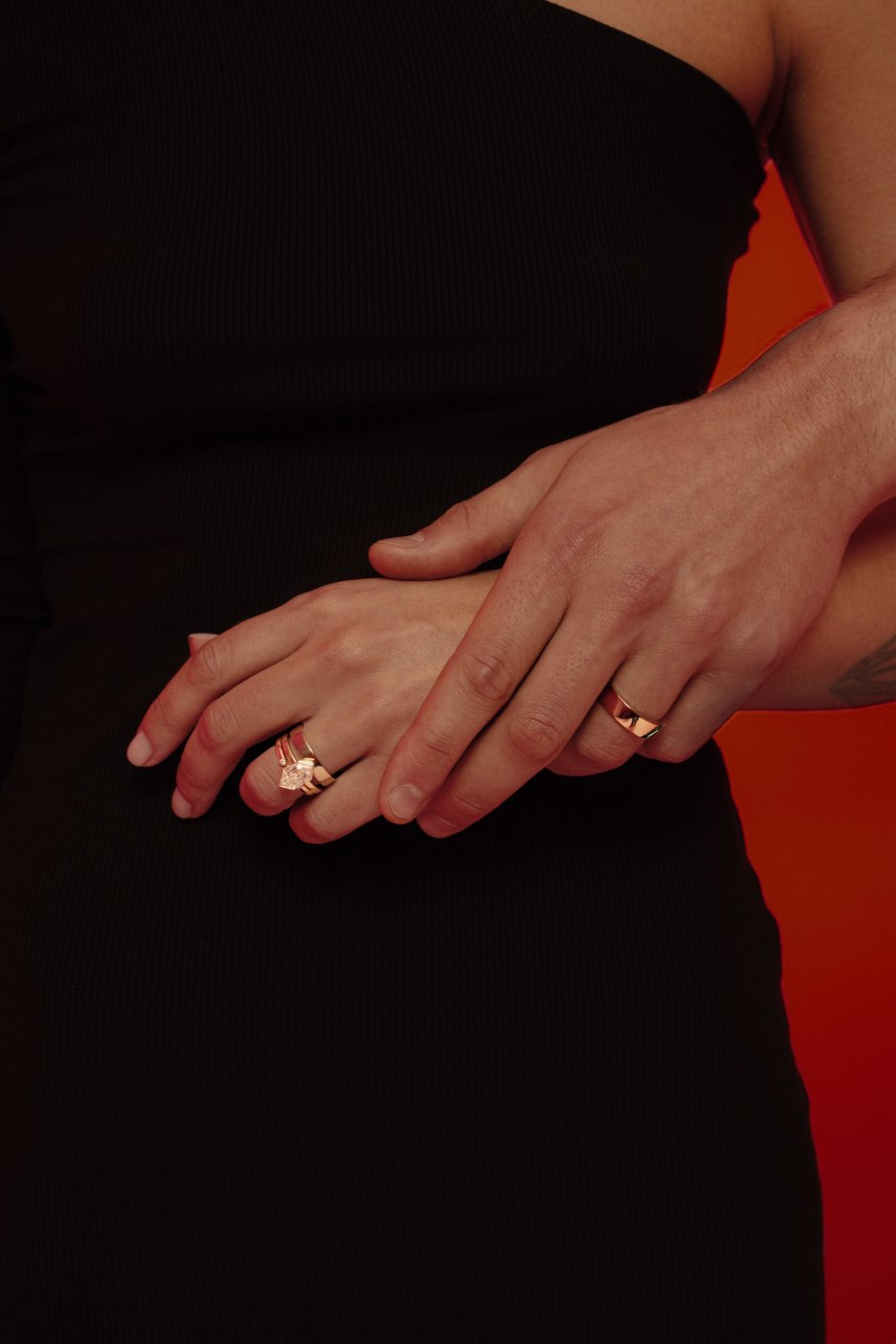Origins of Mined and Lab Grown Diamonds

Mined and lab grown diamonds have completely different ways of getting made to you even though they are optically, physically and atomically exactly the same. They don’t share the same history.
And ever since the release of the film Blood Diamond in 2006, the diamond industry has come under a lot of scrutiny about its ethics, environmental damage and murky supply chains. Since then, the mined diamond industry created the Kimberley Process to ensure that the global supply chain of diamonds would become more ethical.
But even with this process, problems remain. Sustainability has also become a growing talking point. And things are changing. Diamond market research firm VMEye suggests that up to 70% of millennials would consider buying a lab grown diamond for an engagement ring.
This article will walk you through the different ways in which a mined and lab grown diamond are made, and how they get to you.
How Are Diamonds Formed?
A mined natural diamond is a form of crystallised carbon that is created around 160km below the Earth's surface over millions of years. Extreme heat and extreme pressure push the carbon atoms together so densely that they form a diamond. In terms of temperature, the carbon faces around 1100°C and around 13 tons per centimeter.
Because we can't drill down 160km into the Earth's crust into the mantle, the only reason diamonds can be found is because they reach the surface through volcanoes. No eruption in recent times has meant diamonds reaching the surface.
It most likely happened when the Earth was hotter. But it doesn't rain diamonds during a volcano. Instead, the diamonds are held within Kimberlite pipes. And the diamonds need to be separated from the rock.
Only very specific types of volcanoes bring diamonds to the surface. These are called Kimberlite volcanic eruptions. If the molten lava moved too slowly towards the Earth's surface, the diamond just turns into graphite along the way. With the eruption happening quickly, the carbon gets locked into place forming a diamond. This is Earth’s way of growing diamonds. It is also worth noting that the diamonds from volcanoes are not necessarily jewellery quality. They can come in all shapes, sizes and impurities. Many have Boron, Nitrogen and Phosphorus impurities and can look blue-grey (similar to a moon rock).
If all of the diamonds were graded by the likes of IGI and GIA, most of their colour rating would be J+ (very low on the colour spectrum and sold for cheap). Most of these diamonds are not shiny even to the naked eye and are also not worth much (often called brown diamonds).
Diamond is such a strong material because each carbon atom has three bonds with three other carbon atoms. The extreme heat and pressure ensure a strong bond between each carbon atom creating a crystalline structure. One carat of diamond contains billions of carbon atoms that lock into place in a very specific way.
Diamond inclusions occurs when non-diamond materials (i.e., Boron, Nitrogen etc) get trapped inside the crystalline structure.
Diamonds coming from the Earth is not guaranteed in a Kimberlite volcano. Diamonds may start to grow under the specific conditions to be a diamond but then something might change. A change in conditions or too many impurities can stop a diamond from growing. A diamond would need to start growing again and this can take millions of years.
After a Kimberlite volcano, diamonds come closer to the Earth's surface. But because these volcanoes happened millions or billions of years ago, they start to work their way back towards the Earth's mantle. This is why diamonds are mined.
How Are Diamonds Mined?
There are three ways that diamonds are mined from the Earth: pipe mining, alluvial mining and marine mining.
1 Pipe Mining
There are two types of pipe mining: open-pit and underground mining.
a) Open-Pit Mining
Open-pit mining is the process of removing layers of sand and rock found just above the kimberlite. Once diamond is found, a pit is formed and the rock is broken by blasting. Excavators then start to load up the rock for it to be crushed and the diamonds are then separated. Larger carat weights are cut into smaller ones for jewellery.
b) Underground Mining
Similar to coal mining, tunnels are dug beneath the Earth's surface. Two layers of tunnels are formed. On the level closest to the Earth (level 1), blasting is done and Kimberlite then falls into the deeper layer (level 2) through a lining of funnels between the two layers. Similar to open-pit mining, excavators then start to load up the rock for it to be crushed and the diamond to be separated.
You can’t mine coal and turn it into diamond. Coal mining comes from plant debris and fungi. The impurities make it extremely unlikely for them to be turned into diamonds. Also, the carbon in coal doesn't go as deep as the carbon in diamond so it doesn't face the same high temperature and high pressure.
2 Alluvial Mining
Kimberlite pipes do not always go back towards the Earth. Sometimes they remain on the surface and get eroded by wind and water. These are typically then carried downstream. The kimberlite pipe begins to erode and leave rough diamonds.
For alluvial mining to be financially feasible, mining companies build large walls to collect the water.
Diamonds are found on the gravel layer alongside mud, clay, other rocks and plants. Alluvial mining has destructive implications for the environment as ecosystems are disrupted to find diamonds, just like with pipe mining.
3 Marine Mining
Marine mining is extracting diamonds from the seabed. The earliest instance of marine mining was shore divers collecting diamonds off a shallow seabed.
Today, diamond miners use special ships with crawlers that remove gravel off the seabed through hoses (disturbing the natural ecosystem along the way). If the diamonds are below the surface, the miners can also use a large drill.
Because the boats need to be space-efficient, they need to extract as much diamond as possible and leave as much sediment behind. So the hoses pull up the seabed and on the ship, the diamonds are extracted. The rest is then dumped back into the sea. The seabed isn't just "sediment." It typically includes aquatic life. Disrupting this disrupts the natural ecosystem.
Scientists have warned against this type of ecological destruction because no one really knows how long it will take for an ecosystem to regenerate — if ever.
Sustainability of Mined Diamonds
The three steps so far discussed is only part one of the diamond mining process. There are five more processes that still need to happen.
- Crushing of the rock
- Scrubbing
- Cyclonic separation (separating the diamond from rock)
- Recovery of diamonds
- Cleaning, weighing and packaging
Mined diamonds have a huge environmental cost. According to the Diamond Council, for a single carat of diamond, an estimated 250 tons of earth is shifted. You can read more about the impacts here.
Furthermore, for one carat of diamond, around 160kg of CO₂ is produced. The mined diamond industry will point to a report that they commissioned through the Diamond Producers Association claiming that lab diamonds have a carbon cost of 510kg of CO₂ per polished carat (note that this can be seen as a biased source).
Nonetheless, what they don't tell you is that of the diamonds that are mined, only 20% have retail value. Many of the diamonds that are mined are not fit for retail, and even if they are, they are sold extremely cheaply. They are called brown diamonds (very low on the colour spectrum on the 4Cs). This should multiply the cost of producing one carat to a lot higher for each carat of diamond.
If you are looking for a climate positive diamond, look no further than Four Words. Not only do we offset our carbon, we do so by a factor of five. We are climate positive.
How Are Lab Grown Diamonds Made?
There are two processes that lab grown diamonds are made through:
- High-Pressure High Temperature (HPHT) and;
- Chemical Vapor Deposition (CVD).
Process 1: High-Pressure High Temperature (HPHT)
The HPHT process mimics the processes that occur naturally with naturally formed diamonds. It starts off with carbon chains that are not yet fully crystallised (often called 'premature diamonds' or 'diamond seeds' which are carbon chains of typically graphite) and then applying the same types of temperature and pressure as found deep within the Earth.
There are five main stages to an HPHT diamond:
- The diamond seed is placed in a designed press or 'containment cube.' This is done by a highly trained gemologist to ensure that the seed will turn into a crystalline structure.
- The containment cube is heated to about 1500°C and around 12 tons of pressure per centimeter. These are very similar conditions found deep in the Earth's mantle. Catalysts are also added such as iron, nickel or cobalt to lower the amount of energy and pressure needed to complete the reaction from diamond seed to diamond crystal.
- Any metal in the carbon seed dissolves away and leaves a high purity carbon source. This becomes the foundation of the diamond.
- Carbon atoms rain down on the small diamond seed crystal and the diamond itself starts to grow.
- Within a few weeks, the diamond crystal structure is formed. It is then cooled, cut and polished by a diamond cutter.
It is important to note that HPHT are not 'fake' diamonds, moissanites or cubic zirconias. They are natural diamonds. The process is exactly the same as naturally forming diamonds. The only difference is that the HPHT process happens in a lab and not below the ground. A good analogy that we use is ice from Antartica or ice from a freezer? However it is made, it is still ice.
Process 2: Chemical Vapor Deposition (CVD)
Another method for creating lab grown diamonds is the chemical vapor deposition process. In this process, diamonds are grown from a hydrocarbon gas mixture (like methane) where it undergoes an increase in temperature and pressure in a vacuum chamber. There are six key steps to creating a lab grown diamond from the CVD process:
- Just like with the HPHT process, diamond seeds are placed in a diamond growth chamber.
- Before there is an increase in temperature and pressure, the chamber is filled with a hydrocarbon gas mixture.
- Then the chamber is heated to around 1,000°C
- A microwave beam causes the carbon to rain out of the hydrocarbon gas mixture (which is now a plasma cloud) onto the diamond seed which then starts to turn into a crystal. The hydrogen in the hydrocarbon gas etches off any non-diamond carbon.
- The diamonds are removed every few days to have the top of its surface polished. This ensures that any impurities are removed so it can continue to grow.
- This stop-start nature happens a few times and it takes about three to four weeks to go from diamond seed to a diamond that is ready to be cut and polished.
The CVD method was developed in the 1980s and unlike HPHT, it does not require as high pressures which means it can be done with using less energy. And while the process of coming to a polished diamond is not the same as the one found in nature, the outcome of a diamond is exactly the same — optically, physically and atomically exactly the same as HPHT and the natural Earth process.
Lab grown Diamonds Are The Same As Mined Diamonds
As we have seen throughout the formation of natural and lab grown diamonds, they are very similar (especially HPHT). The process is roughly the same. The only difference is that the natural process occurs below the ground while lab grown diamonds are formed above the ground. This results in the diamonds being optically, physically and atomically exactly the same as mined diamonds.
In July 2018, The US Federal Trade Commission updated the Jewelry Guides. It changed the way diamonds could be described and was opposite to what De Beers advocated for in 2016.
The new guidelines stated that lab grown diamonds are equivalent to "natural" diamonds and "if a marketer uses 'synthetic' to imply that a competitor's lab grown diamond is not actually a diamond, it would be deceptive.' This means that lab grown diamonds are diamonds — just as mined diamonds are.
In 2019, a third party diamond certification lab, The Gemological Institute of America dropped the word 'synthetic' in their grading reports and certification and replaced it with lab grown instead.
We often have to make a trade-off in either price or quality when making a sustainable choice. But for diamonds, you can choose something that is more sustainable, higher quality and more cost effective than the alternative. Diamonds are forever, but the environmental destruction doesn’t need to be.
Get in touch today to get started on your diamond journey.
Frequently Asked Questions
Are lab grown diamonds the same as moissanites?
Lab grown diamonds are optically, physically and atomically the same as mined diamonds. Lab grown diamonds are real diamonds. Moissanites on the other hand are not the same as diamonds. It is its own class of gemstone. While it is difficult to tell from the naked eye, moissanites give off a bit more colour in its shine compared to a diamond which reflects mostly white light.
Moissanites are also physically and atomically different to a diamond. Moissanites contain Silicon.
Are lab grown diamonds as the same as cubic zirconias?
Lab grown diamonds are optically, physically and atomically the same as mined diamonds. Lab grown diamonds are real diamonds. Cubic zirconias on the other hand are diamond simulants. Cubic Zirconias have a completely different set of properties to diamonds — they are much more shiny, have a completely different atomic composition and are much more brittle (they crack and chip a lot more easily). Cubic zirconias are also cheap and are not a recommended gemstone by most jewellers.
Do lab grown diamonds pass a diamond tester?
Yes because lab grown diamonds are optically, atomically and physically exactly the same as mined diamonds. Ice from a freezer or ice from Antartica — it’s still ice! Moissanites and cubic zirconias will fail the diamond tester.
Are lab grown diamonds graded in the same way as mined diamonds?
Yes, lab grown diamonds are mostly graded in the same way as mined diamonds. All diamonds are graded against the 4Cs (Colour, Carat, Cut and Clarity) by the likes of IGI or GIA. But grading reports don’t tell the full story. To get a good quality diamond, you need to go beyond the reports. For example, lab grown jewellers need to pay attention to blue nuance and streakiness. Mined diamonds need to pay attention to diamond impurities.
**Are all lab grown diamonds high quality?**Not all lab grown diamonds are necessarily high quality. Some lab grown diamond growers take shortcuts so you can get more streakiness or blue nuance. There is also a spectrum of colour, cut (which is done by diamond cutters and not machines), clarity and carat sizes.
Is there a visual difference between CVD diamonds and HPHT diamonds?
Both CVD diamonds and HPHT diamonds are real diamonds. But there can be some visual differences. For example, CVD diamonds can have streakiness because of the polishing between the process. And with HPHT diamonds, blue nuance can make your diamond appear slightly blue. Both these ‘imperfections’ can be cleaned by doing post-growth treatment. Working with expert jewellers like those at Four Words will mean you won’t need to worry about all of this! We only work with the best diamonds that the eye can see.












